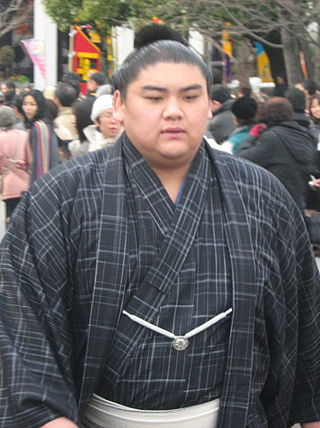
Futen'ō Izumi, is a former sumo wrestler. A former amateur champion, he turned professional in 2003, reaching the top division the following year. He earned two special prizes. His highest rank was komusubi, which he held for one tournament. He retired in May 2011 after falling down the banzuke to the third makushita division. He is now a sumo coach.
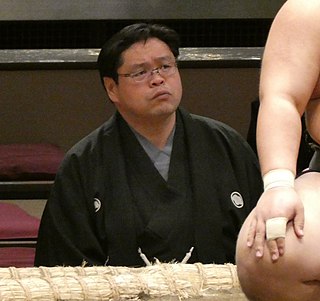
Tochinonada Taiichi is a former sumo wrestler from Ishikawa Prefecture, Japan. An amateur sumo champion, he turned professional in 1996 and reached the top makuuchi division in 1997. He earned twelve kinboshi or gold stars for defeating yokozuna, the second highest ever, and he was a runner-up in two tournaments. His highest rank was sekiwake. He is now a coach at Kasugano stable under the name Takenawa Oyakata.

Toyonoshima Daiki is a former professional sumo wrestler from Sukumo, Kōchi, Japan. He made his professional debut in January 2002, reaching the top makuuchi division in September 2004. He was a runner-up in five tournaments, and earned ten special prizes. His highest rank was sekiwake, which he first reached in September 2008 and held for five tournaments in total. Following a suspension in July 2010 he was demoted to the jūryō division, but upon his return to makuuchi in November 2010 he took part in a playoff for the championship. He won four kinboshi or gold stars awarded for yokozuna upsets, three of them earned by defeating Harumafuji from 2013 to 2015. He wrestled for Tokitsukaze stable. He retired in 2020 and was an elder of the Japan Sumo Association under the name of Izutsu-oyakata until his departure from the association in January 2023.

Satoyama Kōsaku is a retired professional sumo wrestler from Ōshima, Kagoshima Prefecture, Japan. A former amateur sumo champion at Nihon University, he entered professional sumo in 2004 and first reached the top makuuchi division in 2007. His highest rank was maegashira 12. He spent much of his career in the jūryō and makushita divisions, and won a yusho or tournament championship in each. He won promotion back to the top division in 2014 after a seven-year and 37-tournament absence, the longest ever. He was a member of Onoe stable. He retired in November 2018 and is an elder of the Japan Sumo Association under the name of Chiganoura.

Jūmonji Tomokazu is a former sumo wrestler from Aomori, Japan. Joining the professional ranks in 1992, he reached the top division in 2000 and was ranked there for 34 tournaments until 2007. His highest rank was maegashira 6. He was forced to retire in April 2011 after an investigation by the Japan Sumo Association found him guilty of match-fixing.

Ryūhō Masayoshi is a former sumo wrestler from Nakagami, Okinawa, Japan. His highest rank was maegashira 16.

Towanoyama Yoshimitsu is a former sumo wrestler from Toshima, Tokyo, Japan. He made his professional debut in 1993. His highest rank was maegashira 13, achieved in March 2002. He had many injury problems and had perhaps the unluckiest top makuuchi division career of any wrestler in sumo, being injured before even fighting a match in the division. He is the only wrestler since the beginning of the Shōwa era in 1926 to have been ranked in the top division without winning any bouts there.

Tochinowaka Kiyotaka is a former sumo wrestler from Wakayama Prefecture, Japan. A former amateur champion, he turned professional in 1985, reaching the top makuuchi division in 1987. His highest rank was sekiwake. He was a runner-up in one tournament and earned six special prizes and four kinboshi. After 76 tournaments and 1114 bouts in the top division he retired in 1999. He is now an elder of the Japan Sumo Association and the head coach of Kasugano stable.

Kasugano stable is a stable of sumo wrestlers, part of the Dewanoumi ichimon or group of stables. As of January 2023 it had 17 wrestlers. It has been led by former sekiwake Tochinowaka Kiyotaka since 2003. It was one of the most successful stables in 2013, with six sekitori wrestlers, including now retired Georgian Tochinoshin and Japanese born Tochinowaka Michihiro, who used the current head coach's old ring name.

Aran Hakutora is a Russian former sumo wrestler. He began his professional career in January 2007 and made the top division in a record eleven tournaments. The highest rank he reached was sekiwake. He was runner-up in consecutive tournaments in May and July 2010 and earned two sanshō or special prizes for Fighting Spirit. He wrestled for Mihogaseki stable.
The following are the events in professional sumo during 2009.
Ōzutsu Takeshi is a former sumo wrestler from Mie, Japan. Beginning his professional career in May 1971, he was ranked in the top makuuchi division continuously from March 1979 to January 1992, and his record of 1170 consecutive bouts there is the second best in history after Takamiyama. His highest rank was sekiwake. He was runner-up in one tournament and earned ten kinboshi or gold stars for defeating yokozuna. He also won four sanshō or special prizes. He wrestled for Taihō stable and after his retirement in May 1992 he worked there as a coach before leaving the Japan Sumo Association in 2008.
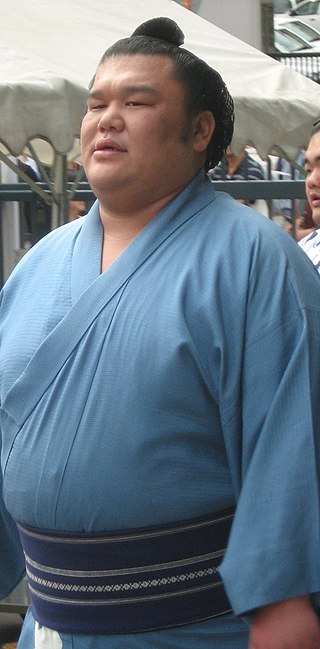
Kimurayama Mamoru was a Japanese professional sumo wrestler. His highest rank was maegashira 7. He was a coach at Kasugano stable. He was the only wrestler in the elite ranks in his time from Wakayama Prefecture.

Mōkonami Sakae is a former sumo wrestler from Mongolia. After making his professional sumo debut in March 2001, he had his top makuuchi division debut 8 years later in July 2009. His highest rank was maegashira 6. He has acquired Japanese citizenship. In April 2011 he was ordered to retire by the Japan Sumo Association after an investigation found him guilty of match-fixing.
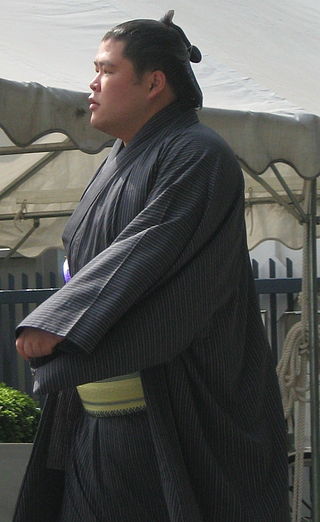
Tosayutaka Yūya is a former sumo wrestler from Tosa City, Kōchi Prefecture, Japan. He made his professional debut in March 2007, reaching the top makuuchi division in July 2009. His highest rank was maegashira 1. After a long hiatus due to injury, he worked his way back up the ranks, logging several lower division championships on the way. In January 2015 he finally reached the top division again after an 18 tournament absence. His comeback from sandanme 84 was the lowest any wrestler since World War II has fallen and still managed to again reach the top division, until surpassed by Terunofuji. After further injury setbacks he announced his retirement in January 2016. He became stablemaster of Tokitsukaze stable in February 2021 after the Japan Sumo Association asked the previous stablemaster to retire.

Sōkokurai Eikichi is a former professional sumo wrestler from Inner Mongolia, China. He is the only Chinese national to reach the top makuuchi division. Sōkokurai is of Mongolian descent. He made his professional debut in 2003 and was promoted to the top division in September, 2010.

Tokushōryū Makoto is a Japanese former professional sumo wrestler from Nara. An amateur sumo competitor while studying at Kinki University, he joined Kise stable and made his professional debut in January 2009. He won championships in the jonokuchi, sandanme and jūryō divisions, and first reached the top makuuchi division in July 2013. After spending most of 2018 and 2019 in the second tier, Tokushōryū returned to makuuchi in January 2020 and recorded 14 wins to take an upset top-division championship victory at the age of 33. He retired from competition in September 2023 and is now coaching at Kise stable as an elder. His highest rank was maegashira 2, and he earned one kinboshi and two special prizes in his career.
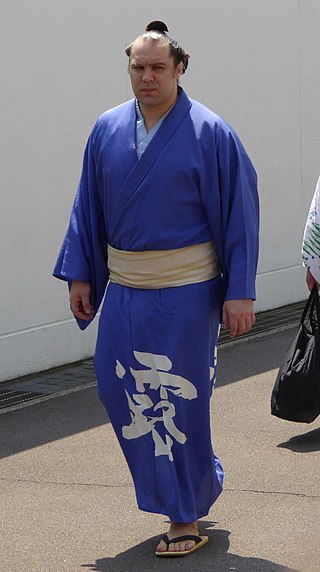
Amūru Mitsuhiro is a former professional sumo wrestler from Lesozavodsk, Primorsky Krai, Russia. After an initial influx of Russian wrestlers from the early 2000s, he was the last ethnic Russian in top level sumo. He made his debut in May 2002 and, after a serious knee injury in 2012 sent him down the rankings, reached the top makuuchi division in November 2014. His highest rank was maegashira 5. He had nine tournaments ranked in the top division, but finished his career in the third highest makushita division.

Kagamiō Hideoki is a former Mongolian-born professional sumo wrestler from Ulaanbaatar. He made his debut in July 2003 for Kagamiyama stable. He reached the jūryō division in January 2013 and the top makuuchi division a year after that. His highest rank was maegashira 9. Following a long-term injury layoff he fell off the banzuke or ranking sheets in 2021. In March 2023 he obtained Japanese citizenship.

Meisei Chikara is a Japanese professional sumo wrestler from Setouchi, Kagoshima. He debuted in sumo wrestling in July 2011 and made his makuuchi debut in July 2018. His highest rank has been sekiwake. He wrestles for Tatsunami stable. Unusually for a top-class sumo wrestler, he uses his given name as his shikona.



















